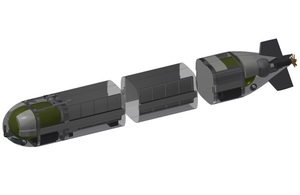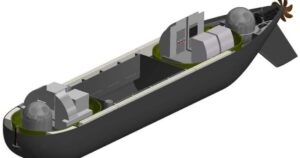The U.K. Royal Navy recently awarded MSubs a $19 million contract to buy a new 39-foot uncrewed submarine, called Project Cetus.
The U.K. Ministry of Defense announced the award on Dec. 1. It said the vessel will be delivered in two years and used to protect national infrastructure and monitor subsurface activity.

The ministry underscored Project Cetus will be “the largest and most complex crewless submarine operated by a European Navy.”
The vessel is named after a mythological sea monster but the U.K. will use it for autonomous underwater experimentation as the first step in developing an operational autonomous submarine working with crewed submarines like the Astute-class attack submarines.
“Cetus will be a platform for the Royal Navy on which to experiment and build cutting edge technologies and capabilities around, encouraging innovation and developing best practice. The unarmed vessel is battery powered, meaning its effective range can be increased by installing additional batteries,” the government said.
Cetus is also designed to be modular, with an optional section that can be added on to double the vessel’s capacity.
Project Cetus is slated to have a maximum operational depth greater than the current submarine fleet, with a range of up to 1,000 miles per mission. It will also be over 7 feet in diameter and weigh almost 19 tons.
The ministry noted it will be able to fit inside a shipping container and is designed to operate with all ships from the Royal Navy and U.K. allies.
The government said this “bespoke vessel” is being specially built in Plymouth and is expected to create 10 new jobs and support 70 other specialist jobs.
“In order to meet the growing threats to our underwater infrastructure, the Royal Navy needs to be ahead of the competition with cutting edge capabilities. Project Cetus, alongside bringing forward the MROS ships, will help ensure we have the right equipment to protect the security of the U.K. and our Allies,” Defense Secretary Ben Wallace said in a statement.

“The faith the Royal Navy has shown in our small business is humbling and we look forward to working closely together in the future, as we have in the recent past, to develop and deploy Cetus, in the national interest,” Brett Phaneuf, chief executive officer at MSubs, added.
The Royal Navy said Cetus is planned to be a subsurface equivalent of the previously procured dedicated tech trials ship, the XV Patrick Blackett. The Royal Navy uses that vessel to test and assess new equipment and determine how it can be integrated or used with the fleet.
“This Extra Large Autonomous Underwater Vehicle is a capability step-change in our mission to dominate the underwater battlespace. And I am delighted that the project is able to support a small, innovative U.K. company which is at the cutting edge of this sector,” First Sea Lord Admiral Sir Ben Key said.
The Defense Ministry noted the $19 million contract was funded via the Anti-Submarine Warfare Spearhead program, which is run out of the Royal Navy’s Develop Directorate in Portsmouth and Cetus is expected to be delivered from the Submarine Delivery Agency in Bristol.